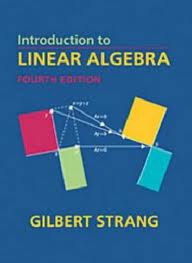Math 3110, Spring 2014
Math 3110, Spring 2014
 "You see this little hole? This moth's just about to emerge. It's in
there right now, struggling. It's digging it's way through the thick
hide of the cocoon. Now, I could help it - take my knife, gently widen
the opening, and the moth would be free - but it would be too weak to
survive. Struggle is nature's way of strengthening it."
"You see this little hole? This moth's just about to emerge. It's in
there right now, struggling. It's digging it's way through the thick
hide of the cocoon. Now, I could help it - take my knife, gently widen
the opening, and the moth would be free - but it would be too weak to
survive. Struggle is nature's way of strengthening it."
--Locke (Lost, 2004)
Resources
• Class
Syllabus
• Text: Introduction to Linear Algebra, 4th edition, by
Gilbert Strang.
• The author, Professor Gilbert Strang of MIT taught Linear Algebra in the Fall of 2011 out of
his textbook. The
lectures were videotaped and are part of the
MIT
OpenCourseWare (OCW) project.
• Course structure: This will be a "half-flipped"
course. Students will be required to watch roughly one video lecture a
week on their own time. To make up for this, roughly one in-class
period a week will be allocated as an interactive problem solving
session, with a special focus on homework problems.
• A wonderful video lecture on the
Overview of the key ideas of linear algebra by Gil
Strang.
• Math 3110 course
schedule.
Homework
Homework 1: pdf |
tex. Due Friday,
January 17th.
Homework 2: pdf |
tex. Due
Friday, January 24th.
Homework 3: pdf |
tex. Due
Friday, January 31st.
Homework 4: pdf |
tex. Due
Friday, February 7th.
Homework 5: pdf |
tex. Due
Friday, February 14th.
Homework 6: pdf |
tex. Due
Friday, February 21st.
Homework 7: pdf |
tex. Due
Friday, February 28th.
Homework 8: pdf |
tex. Due
Friday, March 7th.
Homework 9: pdf |
tex. Due
Friday, March 14th.
Homework 10: pdf |
tex. Due
Friday, March 28th.
Homework 11: pdf |
tex. Due
Friday, April 4th.
Homework 12: pdf |
tex. Due
Friday, April 11th.
Homework 13: pdf |
tex. Due
Friday, April 18th.
Homework 14: pdf |
tex. Due
Friday, April 25th.
Exams
• Practice
Midterm 1 (Fall 2012).
• Practice
Midterm 2 (Fall 2012).
• Midterm
1
• Midterm
2
Lecture notes
Part I: Solutions of linear equations and vector spaces
1. Geometry of
linear equations. Strang: Lecture
1, Sections 1.1, 1.2, 2.1.
2. Elimination
with matrices . Strang: Lecture 2, Sections 2.2, 2.3.
3. Multiplication and inverse matrices. Strang: Lecture
3, Sections 2.4, 2.5.
4. LU-factorization. Strang:
Lectures 4
& 5 (1st half), Sections 2.6, 2.7.
5. Vector
spaces, column space, and row space. Strang:
Lectures 5 (2nd half)
& 6, Sections 3.1, 3.2.
6. Solving
Ax=0: Pivot and free variables. Strang:
Lecture 7, Section 3.2.
7. Solving
Ax=b: Homogeneous and particular solutions. Strang:
Lecture 8, Sections 3.3, 3.4.
8. Linear
independence, spanning sets, and bases. Strang:
Lecture 9, Section 3.5.
9. The four
fundamental subspaces. Strang:
Lecture 10, Section 3.6.
10. Other
vector spaces. Strang: Lecture 11, Section 3.2.
11. Application: Graphs and networks. Strang: Lecture
12, Section 8.2.
Part II: Orthogonality, determinants, and eigenvectors
1. Orthogonality. Strang:
Lecture 14, Section 4.1.
2. Projections. Strang:
Lecture 15, Section 4.2.
3. Least
squares. Strang:
Lecture 16, Section 4.3.
4. Orthogonal
bases and Gram-Schmidt. Strang: Lecture 17, Section 4.4.
5. Determinants. Strang: Lecture 18, Section 5.1.
6. Formulas for
determinants. Strang: Lecture 19, Section 5.2.
7. Applications
of determinants. Strang:
Lecture 20, Section 5.3.
8. Eigenvalues
and eigenvectors. Strang: Lecture 21, Section 6.1.
9. Diagonalization. Strang:
Lecture 22, Section 6.2.
10. Application: Markov chains. Strang:
Lecture 24 (1st part), Section 8.3.
11. Application: Fourier series. Strang:
Lecture 24 (2nd part), Section 8.5.
Part III: Positive definite matrices and applications
1. Symmetric
matrices. Strang: Lecture 25 (1st part), Section 6.4.
2. Positive
definite matrices Strang:
Lectures 25 (2nd part)
& 27, Section 6.5.
3. Complex
matrices. Strang: Lecture 26, Section 10.1, 10.2, 10.3.
4. Similar
matrices and Jordan canonical form. Strang:
Lecture 28, Section 6.6.
5. Singular
value decomposition. Strang:
Lecture 29, Section 6.7.
6. Linear
transformations. Strang:
Lecture 30, Section 7.1, 7.2.
7. Change of
basis. Strang:
Lecture 31, Section 7.2, 7.3.
8. Left, right,
and pseudoinverses. Strang:
Lecture 32, Section 7.2, 7.3.
 "You see this little hole? This moth's just about to emerge. It's in
there right now, struggling. It's digging it's way through the thick
hide of the cocoon. Now, I could help it - take my knife, gently widen
the opening, and the moth would be free - but it would be too weak to
survive. Struggle is nature's way of strengthening it."
"You see this little hole? This moth's just about to emerge. It's in
there right now, struggling. It's digging it's way through the thick
hide of the cocoon. Now, I could help it - take my knife, gently widen
the opening, and the moth would be free - but it would be too weak to
survive. Struggle is nature's way of strengthening it."